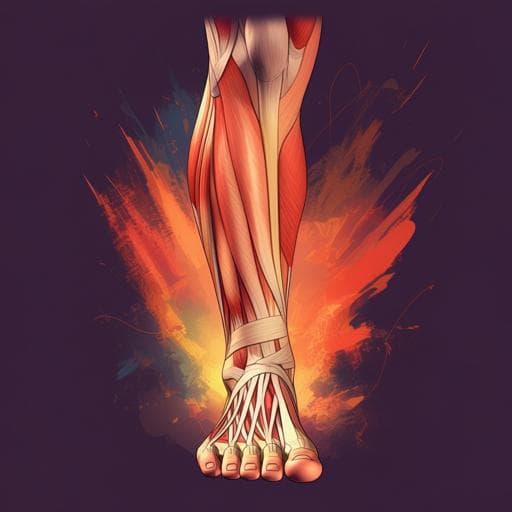
Health and Fitness
Considerations on the human Achilles tendon moment arm for in vivo triceps surae muscle-tendon unit force estimates
D. Holzer, F. K. Paternoster, et al.
This study, conducted by Denis Holzer and colleagues, explores how varying Achilles tendon moment arm-angle functions impact the force-angle relationship of the triceps surae muscle-tendon unit during maximum plantarflexion. The findings reveal that these functions significantly affect force estimations, emphasizing the need for individualized approaches in biomechanical research.
~3 min • Beginner • English
Introduction
Reliable prediction of in vivo muscle forces is critical for understanding muscle mechanics, joint loading, and human locomotion. Because direct measurement of muscle or tendon forces is highly invasive, muscle-tendon unit forces are typically estimated by dividing measured or estimated joint torques by the muscle’s moment arm (MA). The Achilles tendon (AT) transmits triceps surae (TS) forces for plantarflexion. In vivo AT MA is commonly derived via geometric imaging (2D or 3D), tendon excursion, or hybrid ultrasound-motion tracking (UsKin). AT MA varies with joint angle, yet there is no gold-standard moment arm–angle function (MA-a-function). Different MA-a-functions may affect both the magnitude of estimated forces and the shape of the force–angle relationship (F-a-r), potentially complicating interpretation and comparison across studies. Prior work showed such effects for the knee extensors using different patellar tendon MA-a-functions. Accordingly, the authors hypothesized that both the shape and the maximum of the TS F-a-r would differ depending on the AT MA-a-function used.
Literature Review
Three main in vivo methods exist to determine AT moment arms: (1) geometric imaging using MRI or radiography to compute the perpendicular distance from the ankle joint center of rotation to the AT line of action (in 2D or 3D), (2) tendon excursion measuring tendon displacement via ultrasound during passive joint rotation and computing MA as the slope of displacement versus angle, and (3) ultrasound plus motion tracking (UsKin), using a spatially calibrated probe to track the AT line of action and compute geometric MA relative to an estimated ankle rotation axis. Past studies reported variability between methods and across conditions (e.g., rest vs contraction), body size, sex, and anatomy. Some studies observed increased AT MA during contraction compared with rest, while others did not. There is no consensus MA-a-function, and methodological choices (e.g., tendon excursion corrections for passive force) can alter the estimated curvature and magnitude of MA-a-functions. Recent work (e.g., Bakenecker et al.) showed that choice of MA-a-function can change estimated muscle forces and F-a-r in other joints, motivating the present investigation for the triceps surae.
Methodology
Participants: Fourteen healthy males (age 29±6 years; height 180±4 cm; body mass 79±5 kg), right lower limb free from impairments, provided informed consent. Ethics approval by Ruhr University Bochum; procedures followed the Declaration of Helsinki.
Experimental setup: Right-leg maximum voluntary fixed-end plantarflexion contractions (MVCs) were performed on an isokinetic dynamometer (IsoMed2000). Subjects lay prone, knee and hip fully extended. The foot was tightly strapped to a customized foot plate aligned to the ankle axis at rest. Familiarization and standardized warm-up (10 submax eccentric, 10 submax concentric, 3 MVCs) preceded testing.
Torque–angle protocol: MVCs at dynamometer positions: 20° and 10° plantarflexion (PF), 0°, and 5°, 10°, 15°, 20°, 25°, 30° dorsiflexion (DF). Peak active torque from two trials per angle was analyzed. Kinematics (200 Hz, Vicon) with markers on malleoli, femoral condyles, trochanter, and metatarsophalangeal joints captured actual ankle angles and detected heel lift; synchronized with dynamometer (1000 Hz). Three markers on the foot plate monitored deformation. Subject-specific torque–angle relations were fit with a 2nd-order polynomial; angle-specific peak torques were extracted from 20° PF to 25° DF.
Force estimation: TS muscle-tendon unit force was computed as plantarflexion torque divided by the angle-specific AT MA and multiplied by 0.77 to reflect TS’s proportion of plantarflexor PCSA. Fifteen literature-based in vivo AT MA-a-functions (from 17 studies) were digitized where necessary and fit with 2nd-order polynomials over 30° PF to 25° DF; polynomial parameters are reported in the source. For each MA-a-function, individual and group mean F-a-r were calculated.
EMG and ultrasound: Surface EMG (1000 Hz) recorded from gastrocnemius lateralis, soleus, and tibialis anterior per SENIAM guidelines. Gastrocnemius medialis (GM) fascicle length was imaged by ultrasound (7 MHz, 60 mm probe, 61.5 Hz) at ~50% GM length; synchronized via voltage trigger. Fascicle length at peak torque was measured (two raters, three repeats each) in ImageJ; means used for analysis.
Data processing: Torque and angle signals were dual-pass low-pass filtered (4th order, 10 Hz). Passive torque–angle curves were obtained from slow rotations (5°/s) in each direction with EMG control; trials with EMG exceeding rest + 2 SD were excluded and repeated. Active torque was computed as measured MVC torque minus mean passive torque at each angle. EMG was offset-corrected, bandpass filtered 10–500 Hz, rectified, and smoothed (300 ms). Each muscle’s MVC peak across trials provided normalization; tibialis anterior was normalized to peak during separate DF MVCs at 20° DF. GM fascicle length vs angle was fit linearly.
Statistics: Goodness-of-fit for torque–angle and MA-a-functions reported as R². One-way repeated-measures ANOVA with Bonferroni post hoc tested differences in estimated maximum TS force across MA-a-functions and differences in muscle activity across angles. Two-way repeated-measures ANOVA (ankle position × MA-a-function) assessed force differences at each angle. Significant main angle effects were explored with repeated contrasts between adjacent angles to classify ascending, plateau, or descending F-a-r regions (p>0.05 for plateau). Greenhouse–Geisser correction applied as needed; α=0.05.
Key Findings
- Dataset quality and kinematics: Dynamometer lever displacement up to 4.1° (mean 1.9±0.8°) during MVCs; heel lift 1.3±2.1 mm. Actual ankle angles spanned 18.3±3.2° PF to 24.2±5.1° DF (vs dynamometer 20° PF to 30° DF).
- Torque–angle fits: Individual polynomial fits had mean R² 0.94±0.04 (range 0.86–0.99).
- MA-a-function fits: Literature sets by Clarke (2015) and Sheehan (2012) were excluded from analysis due to high variability and small ROM. For the 15 included MA-a-functions, Fletcher (2018) had low fit quality (R²=0.53); the remaining 14 MA-a-functions had mean R² 0.99±0.02 (range 0.93–1.00).
- Peak TS force magnitude: Significant differences across MA-a-functions (p<0.001); mean peak forces ranged from 4312±1156 N to 9947±2194 N. Two-way ANOVA showed significant main effects of ankle position (p<0.001), MA-a-function (p<0.001), and their interaction (p<0.001). Some MA-a-functions produced statistically similar force estimates (e.g., Deforth vs Manal; Maganaris vs Hashizume).
- F-a-r shape dependence on MA-a-function: Deforth (2019) and Hashizume (2012) MA-a-functions yielded TS operating solely on the ascending limb within the tested ROM. All other MA-a-functions showed a plateau region emerging between approximately 13° and 23° DF. Only the Manal (2013) MA-a-function produced a small descending limb beginning at ~23° DF.
- EMG: Tibialis anterior and gastrocnemius lateralis activity did not differ significantly across angles; soleus EMG was significantly reduced at the most plantarflexed position (p<0.05).
- Fascicle behavior: GM fascicle length increased linearly with dorsiflexion; individual linear fits R² ranged 0.75–0.97 (mean 0.89±0.06).
- Methodological trends: Geometric imaging (2D) generally produced larger AT MAs and therefore smaller force estimates (mean peak ~5993±1176 N). Tendon excursion methods showed greater variability depending on how passive loading effects were handled. UsKin-based MAs tended to be smaller than 2D geometric imaging, leading to higher forces.
Discussion
The findings demonstrate that both the magnitude of estimated TS forces and the shape of the F-a-r are strongly influenced by the AT MA-a-function applied. Because MA depends on joint angle and may vary with body size, sex, anatomy, and contraction intensity, using literature-based generic MA-a-functions can lead to substantial differences in inferred muscle capacity and operation range. Method choice also matters: 2D geometric imaging tends to yield larger MAs (smaller forces), tendon excursion results vary with handling of passive tension effects, and UsKin often yields smaller MAs (larger forces). The observed linear increase of GM fascicle length with dorsiflexion suggests that changes in the F-a-r directly imply shifts in the underlying muscle force–length relation; the plateau onset shifted by up to ~10° DF depending on the MA-a-function, potentially affecting interpretations of locomotor efficiency and muscle operating regions. Comparisons with direct AT force measurements indicate that many force estimates from literature-based MA-a-functions are lower than peak forces seen in dynamic tasks (e.g., ~9000 N in running), though the tasks differ (isometric single-joint MVCs vs dynamic multi-joint). Limited direct measurements during fixed-end MVCs (e.g., ~2900 N with knee flexion) are not directly comparable due to joint configuration effects on gastrocnemius length. Emerging shear wave tensiometry can estimate tendon stress but still requires a subject-specific calibration that depends on MA at a single joint configuration. Overall, subject-specific MA measurements—ideally with ultrasound plus motion tracking and, where possible, functional axes of rotation—are recommended to reduce uncertainty, especially when studying movements with varying joint angles and contraction intensities.
Conclusion
Estimated TS force magnitude, optimal joint angle, and F-a-r working range are highly sensitive to the chosen Achilles tendon MA-a-function. A most accurate MA-a-function could not be identified; robust validation against direct force measurements is needed. For researchers estimating TS forces, individualized AT MA measurements using hybrid ultrasound and 3D kinematics are recommended, as they capture inter-individual differences, joint rotation effects, and are feasible across contraction intensities.
Limitations
- Literature MA data emphasized neutral and plantarflexed positions; dorsiflexed MAs required extrapolation, increasing error risk, particularly when based on few measured angles.
- Antagonist co-contraction (tibialis anterior) was monitored by EMG but not subtracted from TS force estimates; prior work suggests minimal effect during fixed-end plantarflexions.
- TS contribution was assumed to be a constant 77% of total plantarflexion moment, which may oversimplify contributions from other plantarflexors with distinct MAs.
- Assumed constant muscle activation across angles; despite familiarization and selection of the highest trial, reduced soleus EMG at extreme plantarflexion could reflect electrode positioning and detection limitations rather than true activation changes.
Related Publications
Explore these studies to deepen your understanding of the subject.







